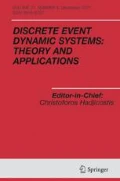Abstract
It is a well known fact that not all max-plus automata can be determinized, i.e. transformed into deterministic max-plus automata with the same behavior. A classical sequentialization procedure, extended in the literature to max-plus automata, succeeds in computing an equivalent deterministic max-plus automaton for important subclasses of max-plus automata. This procedure is based on the normalization of state vectors in order to detect and merge states which have similar future behavior. In this paper, a novel and weaker condition is proposed that still guarantees this property. This allows for a considerable improvement of the existing determinization procedure, because it terminates for a larger class of max-plus automata.






Similar content being viewed by others
Notes
q ∈ Qis said to be accessibleif there exists w ∈Σ∗and qi ∈ Qisuch that\(| q_{i} \overset {w}{\rightsquigarrow } q|\geq 1\). qis said to beco-accessibleif there exists w ∈Σ∗and qf ∈ Qfsuch that\(| q \overset {w}{\rightsquigarrow } q_{f}|\geq 1\). If all its states are accessible and co-accessible, then G is said to be trim.
If, for all w ∈Σ∗, there exists a polynomial function\(P:\mathbb {N} \rightarrow \mathbb {N}\), such that there is at most P(|w|) paths in\(Q_{i} \overset {w}{\rightsquigarrow } Q_{f}\), thenGis said to be polynomially ambiguous.
A max-plus automaton is polynomially ambiguous iff for all q ∈ Q and for all w ∈Σ∗, there is at most one path in \(q \overset {w}{\rightsquigarrow } q\) (see Kirsten 2008).
References
Akian M, Gaubert S, Guterman A (2012) Tropical polyhedra are equivalent to mean payoff games. Int J Algebr Comput 22:12
Allamigeon X, Gaubert S, Goubault E (2013) Computing the vertices of tropical polyhedra using directed hypergraphs. Discret Comput Geom 49:247–279
Aminof B, Kupferman O, Lampert R (2013) Rigorous approximated determinization of weighted automata. Theor Comput Sci 480:104–117
Baccelli F, Cohen G, Olsder G-J, Quadrat J-P (1992) Synchronization and Linearity. Wiley
Béal M-P, Lombardy S, Sakarovitch J, Harrison J, Hirsch EA (2006) Conjugacy and equivalence of weighted automata and functional transducers. In: Grigoriev D (ed) Computer Science – Theory and Applications. Springer, Berlin, pp 58–69
Damljanović N, Ćirić M, Ignjatović J (2014) Bisimulations for weighted automata over an additively idempotent semiring. Theor Comput Sci 534:86–100
Daviaud L, Guillon P, Merlet G (2016) Comparison of max-plus automata and joint spectral radius of tropical matrices. CoRR, arXiv:1612.02647
Droste M, Kuich W, Vogler H (2009) Handbook of weighted automata. Springer Publishing Company, Incorporated
Filiot E, Jecker I, Lhote N, Pérez GA, Raskin J-F (2017) On delay and regret determinization of max-plus automata. In: Proceedings of Symposium on Logic in Computer Science (LICS)
Gaubert S (1995) Performance evaluation of (max,+) automata. IEEE TAC 40 (12):2014–2025
Gaubert S, Mairesse J (1999) Asymptotic analysis of heaps of pieces and application to timed Petri nets. In: Proceedings of Petri Nets and Performance Models, pp 158–169
Kirsten D (2008) A burnside approach to the termination of Mohri’s algorithm for polynomially ambiguous min-plus-automata. RAIRO - TIA 42(3):553–581
Krob D (1992) The equality problem for rational series with multiplicities in the tropical semiring is undecidable. Lect Notes Comput Sci 623:101–112. Springer
Lahaye S, Komenda J, Boimond J-L (2015) Amélioration de la procédure de déterminisation des automates (max,+). In: Modélisation des Systèmes Réactifs, Nancy
Lahaye S, Komenda J, Boimond J-L (2015) Supervisory control of (max,+) automata: extensions towards applications. Int J Control 88(12):2523–2537
Lahaye S, Lai A, Komenda J (2017) Contribution à la déterminisation des automates max-plus. In: Modélisation des Systèmes Réactifs, Marseille
Lombardy S, Mairesse J (2006) Series which are both max-plus and min-plus rational are unambiguous. RAIRO - Theoretical Informatics and Applications, 40
Lombardy S, Sakarovitch J (2006) Sequential?. TCS 359(1-2):224–244
Mohri M (1997) Finite-state transducers in language and speech processing. Comp Lingu 23:269–311
Sakarovitch J (2009) Elements of automata theory. Cambridge University Press
Acknowledgements
We thank the anonymous reviewers for their insightful comments and suggestions. The formulation related to tropical polyhedra given in Lemma 6 has been indicated by one anonymous referee.
Author information
Authors and Affiliations
Corresponding author
Additional information
Publisher’s note
Springer Nature remains neutral with regard to jurisdictional claims in published maps and institutional affiliations.
The work of Jan Komenda is supported by RVO 67985840 and GAČ R grant 19-06175J.
The previous version of this work was presented at MSR 2017, Marseille, France (Lahaye et al. 2017)
Rights and permissions
About this article
Cite this article
Lahaye, S., Lai, A., Komenda, J. et al. A contribution to the determinization of max-plus automata. Discrete Event Dyn Syst 30, 155–174 (2020). https://doi.org/10.1007/s10626-019-00309-6
Received:
Accepted:
Published:
Issue Date:
DOI: https://doi.org/10.1007/s10626-019-00309-6




